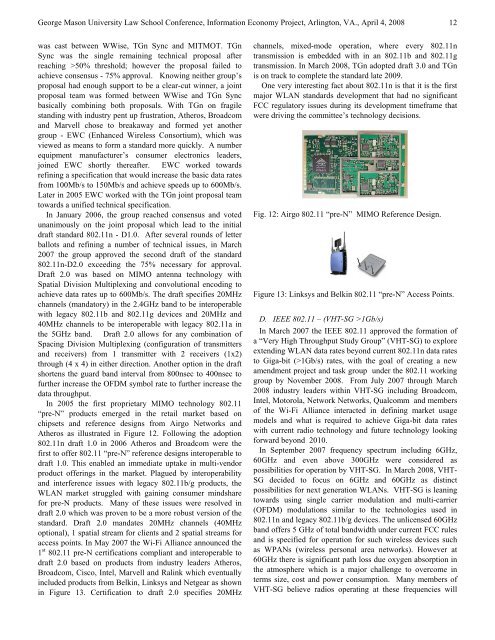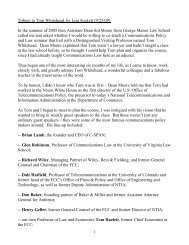History of Wireless Local Area Networks (WLANs) - Information ...
History of Wireless Local Area Networks (WLANs) - Information ...
History of Wireless Local Area Networks (WLANs) - Information ...
Create successful ePaper yourself
Turn your PDF publications into a flip-book with our unique Google optimized e-Paper software.
George Mason University Law School Conference, <strong>Information</strong> Economy Project, Arlington, VA., April 4, 2008<br />
was cast between WWise, TGn Sync and MITMOT. TGn<br />
Sync was the single remaining technical proposal after<br />
reaching >50% threshold; however the proposal failed to<br />
achieve consensus - 75% approval. Knowing neither group’s<br />
proposal had enough support to be a clear-cut winner, a joint<br />
proposal team was formed between WWise and TGn Sync<br />
basically combining both proposals. With TGn on fragile<br />
standing with industry pent up frustration, Atheros, Broadcom<br />
and Marvell chose to breakaway and formed yet another<br />
group - EWC (Enhanced <strong>Wireless</strong> Consortium), which was<br />
viewed as means to form a standard more quickly. A number<br />
equipment manufacturer’s consumer electronics leaders,<br />
joined EWC shortly thereafter. EWC worked towards<br />
refining a specification that would increase the basic data rates<br />
from 100Mb/s to 150Mb/s and achieve speeds up to 600Mb/s.<br />
Later in 2005 EWC worked with the TGn joint proposal team<br />
towards a unified technical specification.<br />
In January 2006, the group reached consensus and voted<br />
unanimously on the joint proposal which lead to the initial<br />
draft standard 802.11n - D1.0. After several rounds <strong>of</strong> letter<br />
ballots and refining a number <strong>of</strong> technical issues, in March<br />
2007 the group approved the second draft <strong>of</strong> the standard<br />
802.11n-D2.0 exceeding the 75% necessary for approval.<br />
Draft 2.0 was based on MIMO antenna technology with<br />
Spatial Division Multiplexing and convolutional encoding to<br />
achieve data rates up to 600Mb/s. The draft specifies 20MHz<br />
channels (mandatory) in the 2.4GHz band to be interoperable<br />
with legacy 802.11b and 802.11g devices and 20MHz and<br />
40MHz channels to be interoperable with legacy 802.11a in<br />
the 5GHz band. Draft 2.0 allows for any combination <strong>of</strong><br />
Spacing Division Multiplexing (configuration <strong>of</strong> transmitters<br />
and receivers) from 1 transmitter with 2 receivers (1x2)<br />
through (4 x 4) in either direction. Another option in the draft<br />
shortens the guard band interval from 800nsec to 400nsec to<br />
further increase the OFDM symbol rate to further increase the<br />
data throughput.<br />
In 2005 the first proprietary MIMO technology 802.11<br />
“pre-N” products emerged in the retail market based on<br />
chipsets and reference designs from Airgo <strong>Networks</strong> and<br />
Atheros as illustrated in Figure 12. Following the adoption<br />
802.11n draft 1.0 in 2006 Atheros and Broadcom were the<br />
first to <strong>of</strong>fer 802.11 “pre-N” reference designs interoperable to<br />
draft 1.0. This enabled an immediate uptake in multi-vendor<br />
product <strong>of</strong>ferings in the market. Plagued by interoperability<br />
and interference issues with legacy 802.11b/g products, the<br />
WLAN market struggled with gaining consumer mindshare<br />
for pre-N products. Many <strong>of</strong> these issues were resolved in<br />
draft 2.0 which was proven to be a more robust version <strong>of</strong> the<br />
standard. Draft 2.0 mandates 20MHz channels (40MHz<br />
optional), 1 spatial stream for clients and 2 spatial streams for<br />
access points. In May 2007 the Wi-Fi Alliance announced the<br />
1 st 802.11 pre-N certifications compliant and interoperable to<br />
draft 2.0 based on products from industry leaders Atheros,<br />
Broadcom, Cisco, Intel, Marvell and Ralink which eventually<br />
included products from Belkin, Linksys and Netgear as shown<br />
in Figure 13. Certification to draft 2.0 specifies 20MHz<br />
channels, mixed-mode operation, where every 802.11n<br />
transmission is embedded with in an 802.11b and 802.11g<br />
transmission. In March 2008, TGn adopted draft 3.0 and TGn<br />
is on track to complete the standard late 2009.<br />
One very interesting fact about 802.11n is that it is the first<br />
major WLAN standards development that had no significant<br />
FCC regulatory issues during its development timeframe that<br />
were driving the committee’s technology decisions.<br />
Fig. 12: Airgo 802.11 “pre-N” MIMO Reference Design.<br />
Figure 13: Linksys and Belkin 802.11 “pre-N” Access Points.<br />
D. IEEE 802.11 – (VHT-SG >1Gb/s)<br />
In March 2007 the IEEE 802.11 approved the formation <strong>of</strong><br />
a “Very High Throughput Study Group” (VHT-SG) to explore<br />
extending WLAN data rates beyond current 802.11n data rates<br />
to Giga-bit (>1Gb/s) rates, with the goal <strong>of</strong> creating a new<br />
amendment project and task group under the 802.11 working<br />
group by November 2008. From July 2007 through March<br />
2008 industry leaders within VHT-SG including Broadcom,<br />
Intel, Motorola, Network <strong>Networks</strong>, Qualcomm and members<br />
<strong>of</strong> the Wi-Fi Alliance interacted in defining market usage<br />
models and what is required to achieve Giga-bit data rates<br />
with current radio technology and future technology looking<br />
forward beyond 2010.<br />
In September 2007 frequency spectrum including 6GHz,<br />
60GHz and even above 300GHz were considered as<br />
possibilities for operation by VHT-SG. In March 2008, VHT-<br />
SG decided to focus on 6GHz and 60GHz as distinct<br />
possibilities for next generation <strong>WLANs</strong>. VHT-SG is leaning<br />
towards using single carrier modulation and multi-carrier<br />
(OFDM) modulations similar to the technologies used in<br />
802.11n and legacy 802.11b/g devices. The unlicensed 60GHz<br />
band <strong>of</strong>fers 5 GHz <strong>of</strong> total bandwidth under current FCC rules<br />
and is specified for operation for such wireless devices such<br />
as WPANs (wireless personal area networks). However at<br />
60GHz there is significant path loss due oxygen absorption in<br />
the atmosphere which is a major challenge to overcome in<br />
terms size, cost and power consumption. Many members <strong>of</strong><br />
VHT-SG believe radios operating at these frequencies will<br />
12




